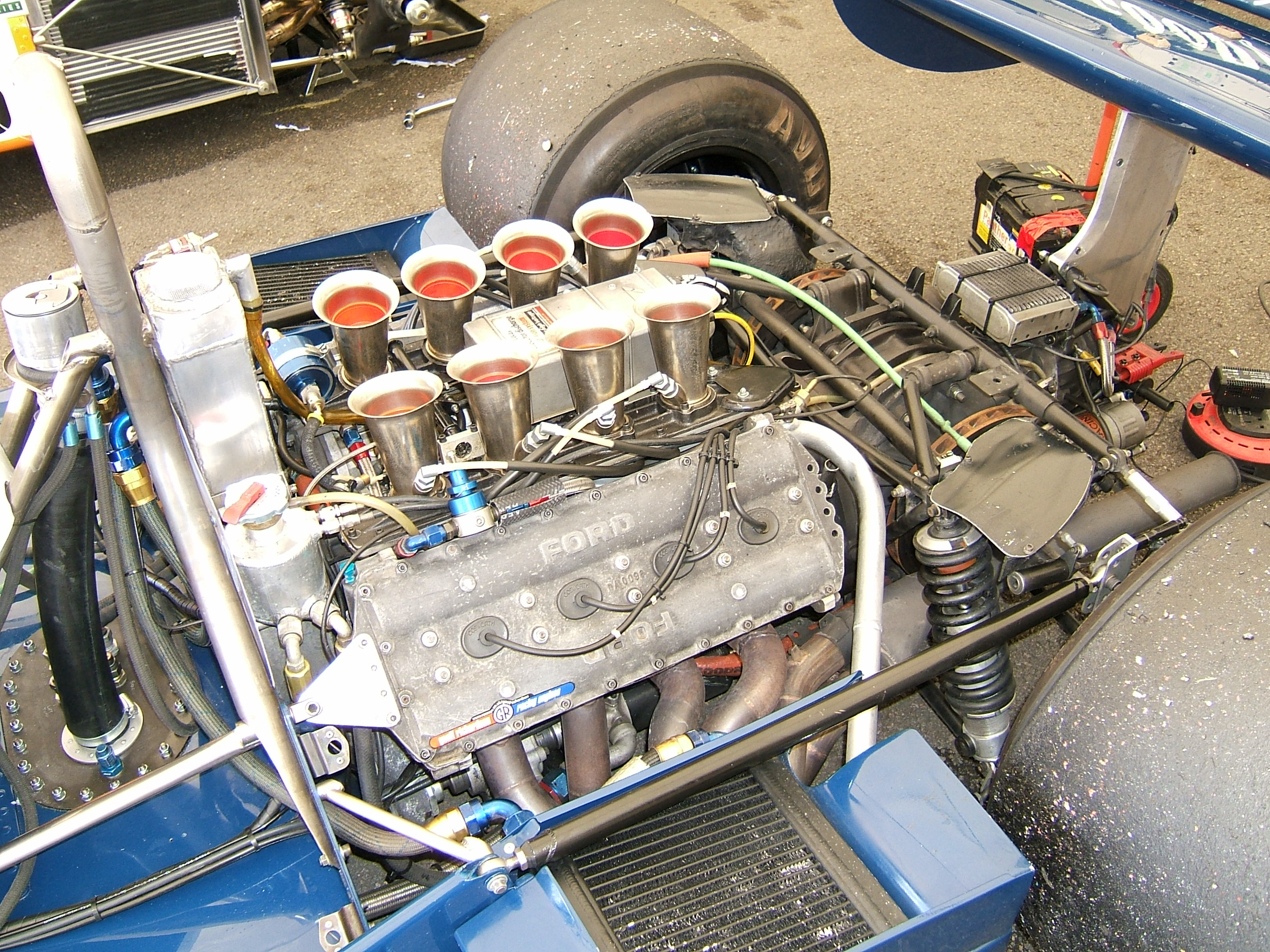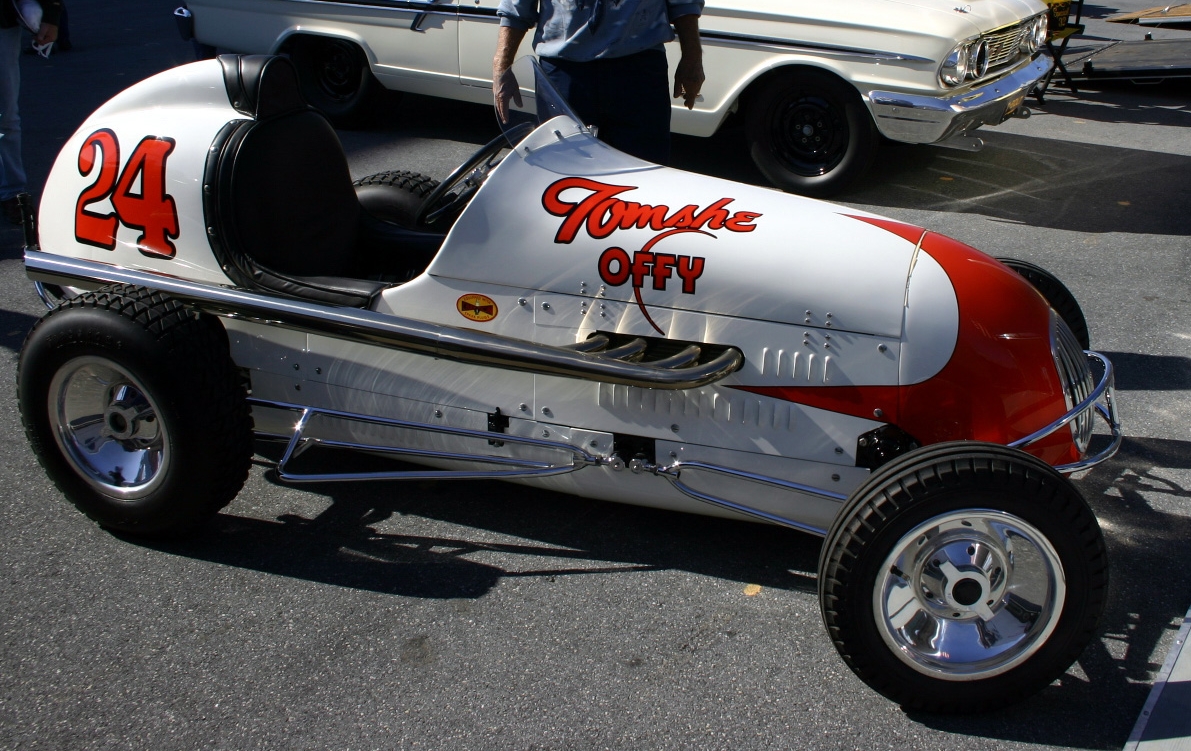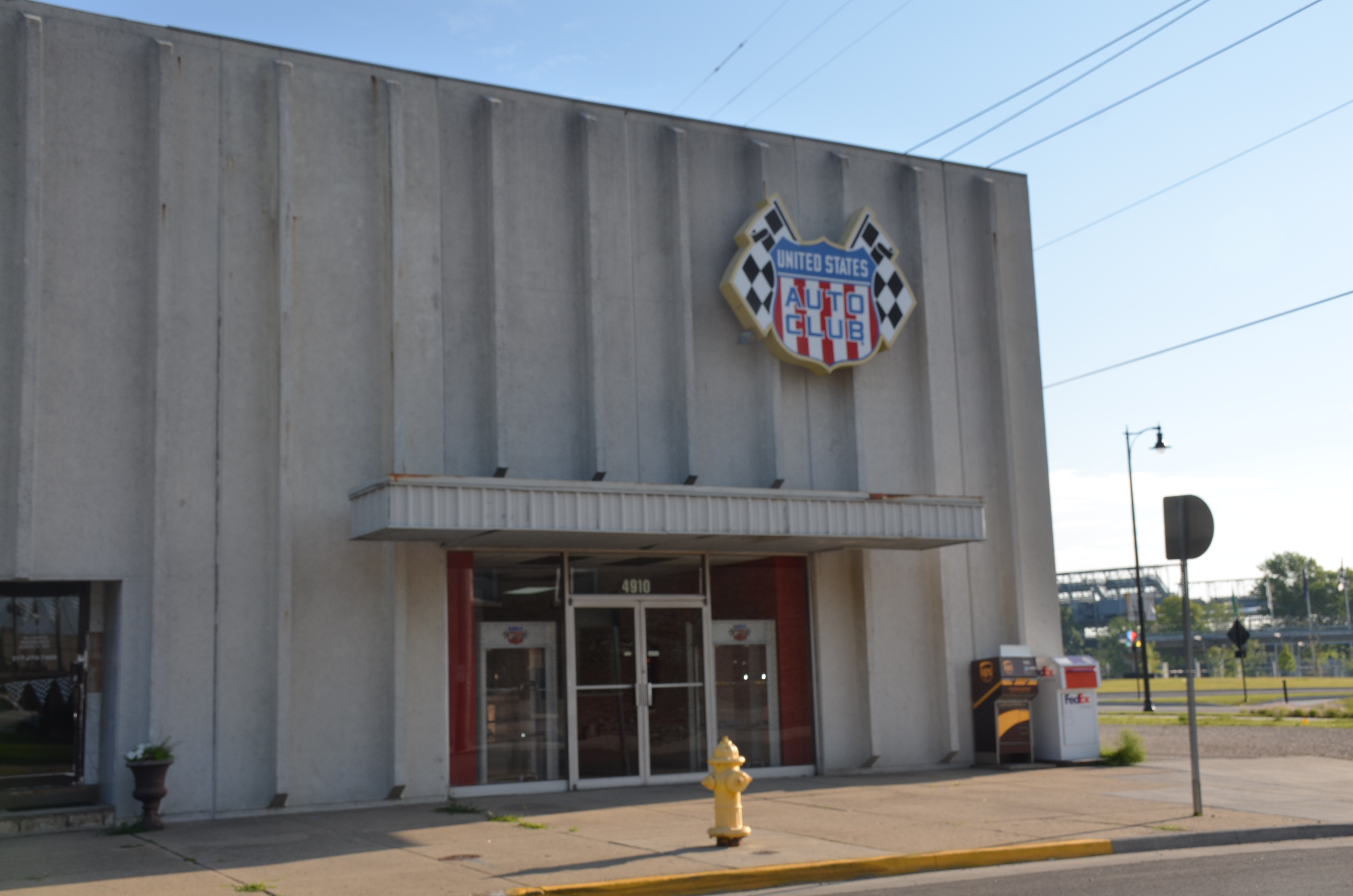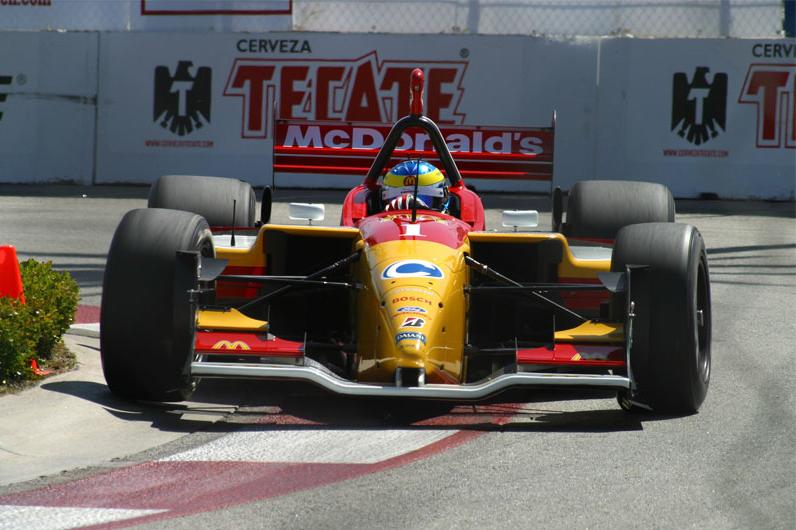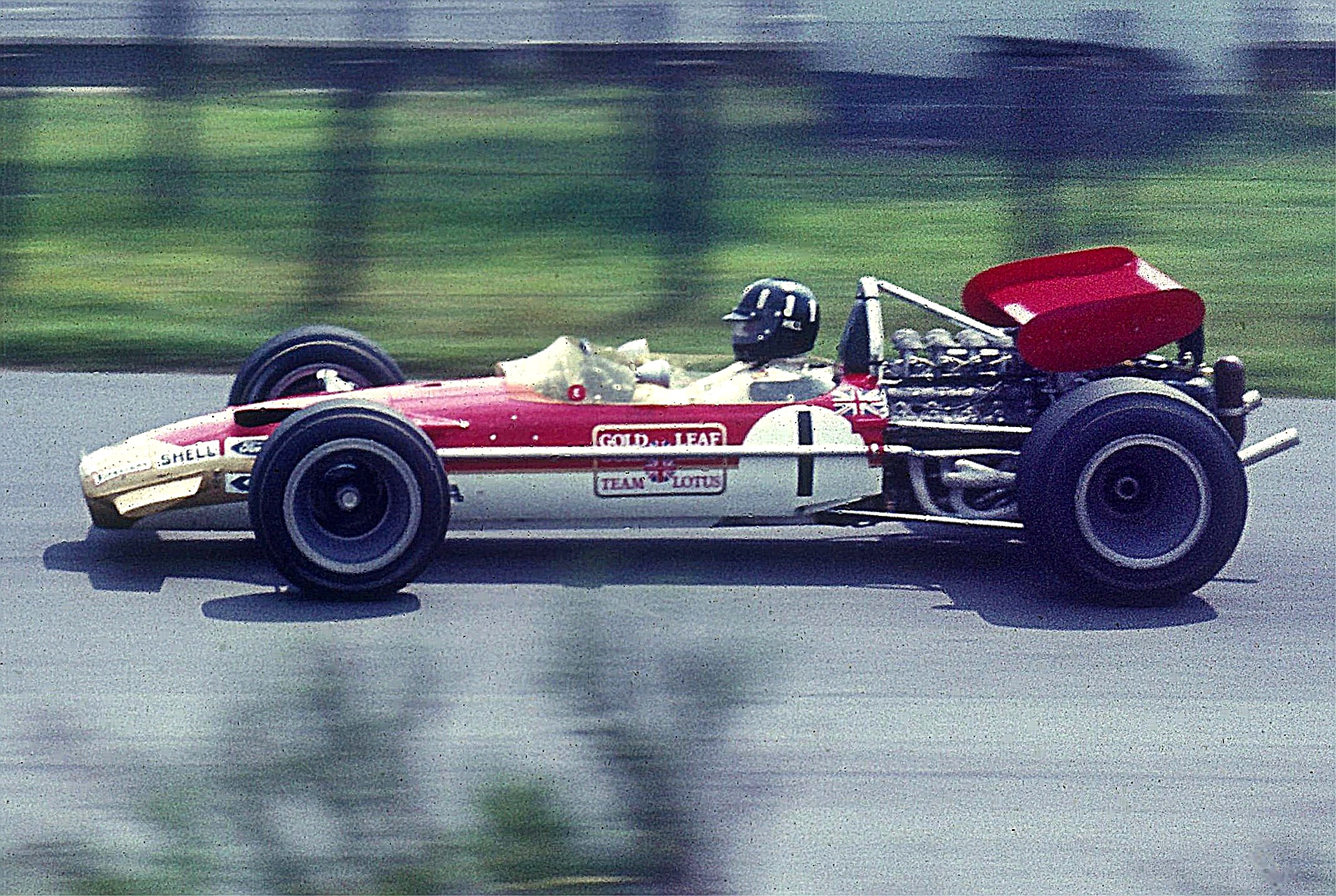|
Ford-Cosworth Indy V8 Engine
The Ford-Cosworth Indy V8 engine is a series of mechanically similar, turbocharged, 2.65-liter, Indy car racing V-8 engines, designed and developed by Cosworth in partnership with Ford. It was produced for over 30 years. It was used in U.S.A.C. Championship Car, C.A.R.T., and later Champ Car World Series; between 1976 and 2007. The DFX engine was the Indy car version of the highly successful 3-liter Cosworth DFV Formula One engine developed by former Lotus engineer Keith Duckworth and Colin Chapman, with financial backing from Ford for the Lotus 49 to campaign the 1967 season. This engine had 155 wins between 1967 and 1985 in F1. The DFX variant was initially developed for Indy car use by Parnelli Jones in 1976, with Cosworth soon taking over. This engine won the Indianapolis 500 ten consecutive years from 1978 to 1987, as well as winning all USAC and CART championships between 1977 and 1987. It powered 81 consecutive Indy car victories from 1981 to 1986, with 153 Indy car vi ... [...More Info...] [...Related Items...] OR: [Wikipedia] [Google] [Baidu] |
Ford Motor Company
Ford Motor Company (commonly known as Ford) is an American multinational automobile manufacturer headquartered in Dearborn, Michigan, United States. It was founded by Henry Ford and incorporated on June 16, 1903. The company sells automobiles and commercial vehicles under the Ford brand, and luxury cars under its Lincoln luxury brand. Ford also owns Brazilian SUV manufacturer Troller, an 8% stake in Aston Martin of the United Kingdom and a 32% stake in China's Jiangling Motors. It also has joint ventures in China (Changan Ford), Taiwan (Ford Lio Ho), Thailand ( AutoAlliance Thailand), and Turkey ( Ford Otosan). The company is listed on the New York Stock Exchange and is controlled by the Ford family; they have minority ownership but the majority of the voting power. Ford introduced methods for large-scale manufacturing of cars and large-scale management of an industrial workforce using elaborately engineered manufacturing sequences typified by moving assembly lines; by ... [...More Info...] [...Related Items...] OR: [Wikipedia] [Google] [Baidu] |
Cosworth DFV
The DFV is an internal combustion engine that was originally produced by Cosworth for Formula One motor racing. The name is an abbreviation of ''Double Four Valve'', the engine being a V8 development of the earlier four-cylinder FVA, which had four valves per cylinder. Its development in 1967 for Colin Chapman's Team Lotus was sponsored and funded by major American automotive manufacturer Ford Motor Company, Ford. For many years it was the dominant engine in Formula One, with the whole engine program funded by Ford's European division, Ford Europe and engines badged as "Ford" for Formula One championship races. DFVs were widely available from the late 1960s to the mid 1980s and were used by every specialist team in F1 during this period with the exception of Ferrari, Alfa Romeo, Renault, BRM and Matra, who all designed, produced and ran their own engines. Variants of this engine were also used in other categories of racing, including Champ Car, CART, Formula 3000 and sports car ra ... [...More Info...] [...Related Items...] OR: [Wikipedia] [Google] [Baidu] |
Motor Sport (magazine)
''Motor Sport'' is a monthly motor racing magazine, founded in the United Kingdom in 1924 as the ''Brooklands Gazette''. The name was changed to ''Motor Sport'' for the August 1925 issue. The magazine covers motor sport in general, although from 1997 to 2006 its emphasis was historic motorsport. It remains one of the leading titles on both modern and historic racing. The magazine's photo library is currently managed by LAT Images, which founded as Motor Sport photographic division by Wesley J. Tee in the 1960s and later spun-off as a stand-alone affiliated company. The magazine's monthly podcasts have featured Christian Horner, Mario Andretti, Patrick Head, Sir Frank Williams, John McGuinness and Gordon Murray. In 1939 the magazine incorporated its rival ''Speed'' (the organ of the British Racing Drivers' Club). Editors * 1936–1991: Bill Boddy * ? – December 1996: Simon Arron * April 1997 – ?: Andrew Frankel (acting editor January 1997 – March 1997) * September ... [...More Info...] [...Related Items...] OR: [Wikipedia] [Google] [Baidu] |
Vels Parnelli Jones
Vel's Parnelli Jones Racing, commonly referred to simply as Parnelli or VPJ, was a motor racing constructor and team from the United States. The team was formed in 1969 by former United States Automobile Club, USAC racer Parnelli Jones and his business partner Velko Miletich, Velko "Vel" Miletich. Parnelli was initially solely concerned with USAC racing, where success came quickly; their driver Al Unser won the Indianapolis 500 race in 1970, driving a VPJ Colt, after leading 190 of the 200 racing laps. Unser went on to win the USAC championship. Unser repeated the Indy 500 win in 1971 with a new Colt built without the left side chassis offset that had been made illegal by 1971 rules, ending the season in fourth place in the USAC drivers points while teammate Joe Leonard won the championship. Racing Parnelli secured the services of ex-Team Lotus designer Maurice Philippe and driver Mario Andretti for USAC racing in the early 1970s, and in 1974 decided to move into Formula One rac ... [...More Info...] [...Related Items...] OR: [Wikipedia] [Google] [Baidu] |
Offenhauser
The Offenhauser Racing Engine, or Offy, is a racing engine design that dominated American open wheel racing for more than 50 years and is still popular among vintage sprint and midget car racers. History The Offenhauser engine, familiarly known as the "Offy", was an overhead cam monoblock 4-stroke internal combustion engine developed by Fred Offenhauser and Harry Arminius Miller. Originally, it was sold as a marine engine. In 1930 a four-cylinder Miller engine installed in a race car set a new international land speed record of . Miller developed this engine into a twin overhead cam, four-cylinder, four-valve-per-cylinder racing engine. Variations of this design were used in midgets and sprints into the 1960s, with a choice of carburetion or Hilborn fuel injection. When both Miller and the company to whom he had sold much of the equipment and rights went bankrupt in 1933, Offenhauser opened a shop a block away and bought rights to engines, special tooling and drawings ... [...More Info...] [...Related Items...] OR: [Wikipedia] [Google] [Baidu] |
United States Automobile Club
The United States Auto Club (USAC) is one of the sanctioning bodies of auto racing in the United States. From 1956 to 1979, USAC sanctioned the United States National Championship, and from 1956 to 1997 the organization sanctioned the Indianapolis 500. Today, USAC serves as the sanctioning body for a number of racing series, including the Silver Crown Series, National Sprint Cars, National Midgets, Speed2 Midget Series, .25 Midget Series, Stadium Super Trucks, and Pirelli World Challenge. Seven-time USAC champion Levi Jones is USAC's Competition Director. History When the American Automobile Association (AAA) withdrew from auto racing after the 1955 season, citing the Le Mans disaster and the death of Bill Vukovich at Indianapolis as contributing factors, both the SCCA and NASCAR were mentioned as its potential successor. Ultimately, USAC was formed by Indianapolis Motor Speedway owner Tony Hulman. It became the arbiter of rules, car design, and other matters for what it te ... [...More Info...] [...Related Items...] OR: [Wikipedia] [Google] [Baidu] |
Turbocharger
In an internal combustion engine, a turbocharger (often called a turbo) is a forced induction device that is powered by the flow of exhaust gases. It uses this energy to compress the intake gas, forcing more air into the engine in order to produce more power for a given displacement. The current categorisation is that a turbocharger is powered by the kinetic energy of the exhaust gasses, whereas a supercharger is mechanically powered (usually by a belt from the engine's crankshaft). However, up until the mid-20th century, a turbocharger was called a "turbosupercharger" and was considered a type of supercharger. History Prior to the invention of the turbocharger, |
Champ Car
Champ Car World Series (CCWS) was the series sanctioned by Open-Wheel Racing Series Inc., or Champ Car, a sanctioning body for American open-wheel car racing that operated from 2004 to 2008. It was the successor to Championship Auto Racing Teams (CART), which sanctioned the 'PPG Indy Car World Series from 1979 until dissolving after the 2003 season. Vehicles Champ Cars were single-seat, open-wheel racing cars, with mid-mounted engines. Champ cars had sculpted undersides to create ground effect and prominent wings to create downforce. The cars would use a different aerodynamic kit on the occasions they raced on an oval. With funds low, development was effectively frozen with a focus on developing a universal chassis, and the series generally ran on CART-spec 2002 Lola chassis from 2003 to 2006. The new chassis was developed by Panoz and debuted in 2007 as the Panoz DP01. The chassis was well received by drivers and fans. The series leased 750hp 2.65 L V-8 turbocharged Coswor ... [...More Info...] [...Related Items...] OR: [Wikipedia] [Google] [Baidu] |
Indianapolis 500
The Indianapolis 500, formally known as the Indianapolis 500-Mile Race, and commonly called the Indy 500, is an annual automobile race held at Indianapolis Motor Speedway (IMS) in Speedway, Indiana, United States, an enclave suburb of Indianapolis. The event is traditionally held over Memorial Day weekend, usually the last weekend of May. It is contested as part of the IndyCar Series, the top level of American open-wheel car racing, a formula colloquially known as "Indy car racing". The track itself is nicknamed the "Brickyard", as the racing surface was paved in brick in the fall of 1909. One yard of brick remains exposed at the start/finish line. The event, billed as ''The Greatest Spectacle in Racing'', is considered part of the Triple Crown of Motorsport along with the 24 Hours of Le Mans and the Monaco Grand Prix, with which it typically shares a date. The official attendance is not disclosed by Speedway management, but the permanent seating capacity is upwards ... [...More Info...] [...Related Items...] OR: [Wikipedia] [Google] [Baidu] |
Parnelli Jones
Rufus Parnell Jones (born August 12, 1933) is an American former professional racing driver and racing team owner. He is notable for his accomplishments while competing in the Indianapolis 500 and the Baja 1000 desert race. In 1962, he became the first driver to qualify over 150 mph. He won the race in 1963, then famously broke down while leading the 1967 race with three laps to go in a turbine car.Biography at the During his career as an owner, he won the Indy 500 in [...More Info...] [...Related Items...] OR: [Wikipedia] [Google] [Baidu] |
1967 Formula One Season
The 1967 Formula One season was the 21st season of FIA Formula One motor racing. It featured the 1967 World Championship of Drivers and the 1967 International Cup for F1 Manufacturers,FIA Yearbook, 1974, Grey Section, pages 117–118 contested concurrently over an eleven race series which commenced on 2 January, and ended on 22 October. The season also included a number of non-championship races for Formula One cars. Denny Hulme won the World Championship of Drivers and Brabham-Repco was awarded the International Cup for F1 Manufacturers. Season summary At the Dutch Grand Prix, Lotus unveiled the new Ford-sponsored Cosworth DFV engine which was to be one of the outstanding racing engines of all time, winning 155 Grands Prix, Le Mans and Indianapolis. Although Jim Clark won four races, Denny Hulme took the title by virtue of his greater consistency. The Repco V8 in his Brabham, which had been the engine to have in , had been surpassed in the power stakes and had to fall back on i ... [...More Info...] [...Related Items...] OR: [Wikipedia] [Google] [Baidu] |
Lotus 49
The Lotus 49 was a Formula One racing car designed by Colin Chapman and Maurice Philippe for the 1967 F1 season. It was designed around the Cosworth DFV engine that would power most of the Formula One grid through the 1970s. It was one of the first F1 cars to use a stressed member engine combined with a monocoque to reduce weight, with other teams adopting the concept after its success. It also pioneered the use of aerofoils to generate downforce. Jim Clark won on the car's debut, in 1967, and it would also provide him with the last win of his career, in 1968. Graham Hill went on to win that year's title and the car continued winning races until 1970. Concept After a difficult first year for Lotus in the three-litre formula using the heavy and unreliable BRM H16 engine, Chapman went back to the drawing board and came up with a design that was both back to basics and forward-thinking. Taking inspiration from earlier designs, particularly the Lotus 43 and Lotus 38 Indycar, the ... [...More Info...] [...Related Items...] OR: [Wikipedia] [Google] [Baidu] |
